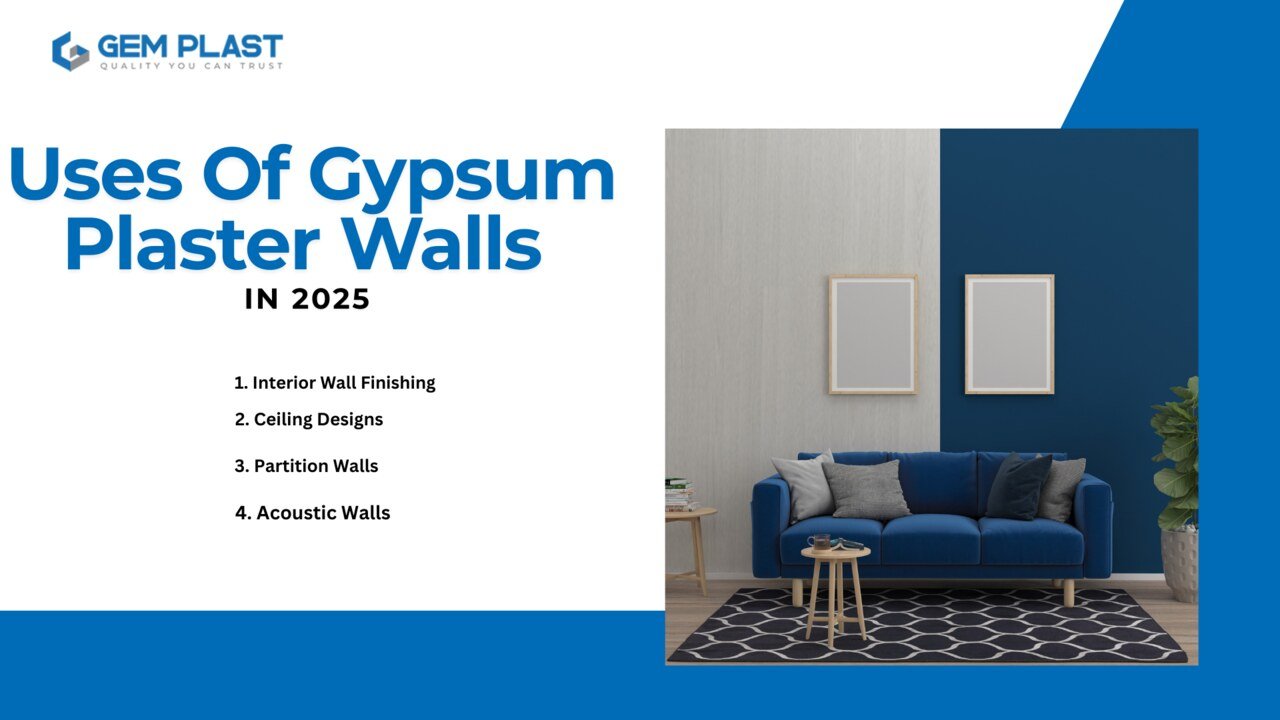What Is Gypsum Plastering? What Is The Role Of gypsum plastering

What is gypsum plastering in kerala? Gypsum is a contemporary method of plastering that uses Gypsum as a material to give an even and long-lasting finish to ceilings and walls. In contrast to traditional cement plastering, gypsum-based plastering removes the requirement for curing with water and drastically Minimizes the time needed to construct. It is sprayed directly on bricks, blocks, or concrete, forming a uniform and seamless layer. This process involves mixing Gypsum with water to create a simple mixture to apply and set quickly.The principal function of Gypsum Plaster is to give a beautiful and functionally efficient appearance. It can improve the interior of walls thanks to its anti-crack properties. It is also well-known for its lightweight properties that reduce the burden on the building. What is gypsum plastering? It also benefits by providing excellent thermal insulation, helping to maintain a comfortable temperature indoors, and its fire-proof nature gives an extra layer of security. Furthermore, it contributes to the contemporary design philosophy by providing smooth surfaces for wallpaper, paint, or textured surfaces.
Advantages Of Gypsum Plastering
What are Gypsum plastering advantages? It is a modern technique of plastering that provides many positives over the traditional method. One of the main advantages is the removal of curing by water, which reduces the time and work. Gypsum plastering gives a smooth, durable finish perfect for painting or decorating. It’s lightweight, which reduces the load on the structure, and provides excellent thermal insulation, ensuring the temperature of your indoor space is comfortable. Furthermore, it is resistant to fire, which increases safety, and its short setup time is a quick and efficient solution. These characteristics add to the advantages that make Gypsum plastering the preferred choice for residential and commercial projects.
1. Smooth and Polished Finish
What is Gypsum plastering gives an elegant and polished look, enhancing any room’s look. The fine texture provides an even surface ideal for wallpapering, painting, or putting decorative patterns on. Contrary to traditional plasters, it removes imperfections on the surface, giving a smooth appearance. This contemporary finish adds style and class to ceilings and walls, creating a visually pleasing.
2. Quick Application and Drying
What is Gypsum plastering is well-known for its rapid application and drying, making it highly effective for construction tasks. The paste, created by mixing gypsum powder and water, quickly spreads and is set for 25-30 minutes. Unlike conventional plaster, this requires no water curing, saving time and energy. The fast drying feature enables subsequent tasks like the painting process or finalization to start sooner, speeding up the project timeline.
3. Lightweight
Gypsum plaster is light and helps reduce the overall burden on the structure of the building. It is a perfect option for modern constructions. The quick drying process speeds up construction since it is set within a few hours after the application. In contrast to traditional plastering, it doesn’t need a lengthy curing process, which saves time and money. Light properties and quick drying make the gypsum plastering process effective and practical for various uses.
4. Crack-Resistant
Gypsum plastering is highly scratch-resistant and provides a long-lasting durability and seamless finish without surface imperfections or shrinkage. The speedy drying process reduces the waiting time and allows subsequent tasks, such as decorating or painting, to be completed without delay. In contrast to traditional plasters, it reduces the chance of cracks caused by curing or drying processes. This means using gypsum plastering is an effective and durable option for today’s construction projects.
5. Thermal Insulation
Gypsum plastering is an excellent thermal insulation, which helps lower indoor temperatures and energy usage. It makes interiors more extraordinary during summer and warmer during winter, increasing the overall comfort. In addition, the drying period for Gypsum is much shorter than that for traditional cement, which allows for quicker construction completion. This means that gypsum-plastering is the ideal option for construction projects at present.
6. Cost-Effective
Gypsum plastering is a cost-effective option since it lowers the value of substances and hard work compared to conventional strategies for plastering. The short-putting properties of gypsum cement reduce the time required for creation, which leads to typical savings. In Enhancement, gypsum plaster dries fast and Regularly and no longer needs an extended curing time, which makes it easier to complete the challenge on time. This makes it a preference for those searching out a low-priced, assertive approach to laying plaster.
Uses Of Gypsum Plaster Walls In 2025

Gypsum plaster walls are a favorite option for creating seamless, long-lasting surfaces in contemporary construction. Constructed from Gypsum, an organic mineral that gives these walls a unidirectional finish that is perfect for painting or decorating. Compared to conventional cement plaster, gypsum plaster walls allow for faster application, a l, design, and excellent resistance to cracks. What is gypsum-plastering in eranakulam? It is a process that improves the appearance of walls by providing thermal and acoustic insulation. Resulting in improved performance in terms of energy efficiency and noise reduction. They are also fireproof, which makes them a safe alternative, and their speedy drying process helps cut down on the overall timeline of projects.
1. Interior Wall Finishing
Gypsum plaster walls are an excellent option for finishing interior walls with a smooth, perfect surface. They are simple to install and provide better crack resistance than traditional plaster. Because of their ability to improve the overall appearance, the walls made of Gypsum can be used to create an attractive look in bedrooms, living rooms, or offices. In addition, they offer thermal insulation and improve the efficiency of indoor areas.
2. Ceiling Designs
Gypsum plaster is an excellent material for creating stunning ceiling designs. It’s versatile and appropriate for complex designs, curves, and contemporary designs like cove or recessed ceilings. Gypsum ceilings offer clean, seamless finishes incorporating lighting fixtures and decorative elements. In addition, they provide advanced insulation and soundproofing properties that decorate both the cultured price and the practicality of the location
3. Partition Walls
Gypsum panels are an ideal option for partitioning walls for commercial and residential spaces. They are light, which makes them simple to put up and move while offering excellent audio insulation in rooms. They provide smooth, polished surfaces that are easy to paint or embellish. In addition, gypsum wall panels are fire-resistant, which offers additional protection in partitioned spaces.
4. Acoustic Walls
What is gypsum-plastering? It is a method that improves acoustics performance by creating walls that minimize sound transmission. What is Gypsum plastering is a method of building Acoustic walls. It provides superior soundproofing properties over traditional methods of plastering. They are great for rooms that require noise control, like studios, offices, and home theatres. The composition and density of gypsum wallboards can help improve sound insulation, which makes the room more comfortable and peaceful.
5. Renovation Projects
Gypsum plastering walls are the ideal choice for renovation projects. They provide the fastest and most efficient method to improve the appearance of existing interiors. They offer an elegant, fresh look that conceals flaws in older walls. Utilizing the what is gypsum plastering method not only enhances the aesthetic appeal. Stialso enhances the structure’s structural integrity by providing the ability to resist cracks and provide ks and long-lasting durability. They are a preferred choice for modernizing homes as well as commercial areas.
Gypsum Plastering Work: Perfect Walls For Perfect Spaces

What is gypsum-plastering? Gypsum plastering involves the utility of gypsum-based substances in ceilings and walls to create a clean, strong, and fascinating floor. The method begins by cleansing the floor to ensure it’s miles free of dust. A mix of gypsum powder and water is sprayed through trowels or spray systems. What is gypsum-plastering? Its benefits include rapid drying, easy application, and crack resistance. It also provides fantastic insulation for the acoustic and thermal globe and improves electricity performance and soundproofing. The Gypsum is speedy after being put in the area, providing a clean and perfect floor for portrayals or other layout techniques.
1. Steps Involved in Gypsum Plastering
The Gypsum plastering begins by preparing the surface by removing and smoothing imperfections. Then, a bonding agent, or primer, is sprayed on the surface to guarantee better adhesion. The gypsum plaster mix is made by mixing the gypsum powder and water, which is then incorporated into the proper consistency. What is gypsum plastering It is then applied evenly on the surface with trowels or spray systems that ensure an even and smooth layer. Once the plaster has been set, all imperfections are smoothed away while the entire surface is allowed to dry, finalizing the Gypsum plastering work.
2. Advantages of Gypsum Plastering Work
What is Gypsum plastering has numerous advantages, making it a popular option in contemporary construction. It is quick-drying, which reduces the overall construction time and allows for faster completion. The smooth finish provided by Gypsum creates an even surface ideal for painting or embellishing. The work of gypsum plastering is also extremely sturdy, durable, and light in weight, which reduces the structural burden. Furthermore, it offers excellent insulation to both acoustic and thermal energy, improving energy’s comfort and efficiency in all spaces.
3. Common Applications of Gypsum Plastering
Gypsum wall plastering is appreciably used for industrial and residential areas to create smooth, robust surfaces. It is frequently applied to ceilings and partitions to make looking for wallpapering, painting, or other ornamental treatments easy. What is gypsum-plastering? It is extraordinarily sought-after in modern-day creation due to its speedy drying time, easy setup, and high resistance to cracks. The maximum standard packages for What is plastering are indoor partitions in offices, homes, hospitals, and schools, as well as accommodations and ceilings in industrial and home spaces. It is also utilized for upkeep tasks to improve the circumstances of damaged or old surfaces.
Conclusion
In the final analysis, what is gypsum plastering? It is a process that involves applying a smooth, clean finish to walls and ceilings using gypsum-based mortar. It is known for its speedy setting time, simple application, and excellent finish, making it an excellent choice for today’s construction projects. Gypsum plastering in india Gemplast is the most premium Gypsum cement; it is more than just an even, smooth finish; it also comes with advantages such as thermal insulation, fire resistance, and less maintenance. Although it is primarily intended to be used in the interior and is eco-friendly and safe, it’s also an extremely durable and secure solution that outperforms traditional concrete plasters in various areas.
Testimonials
Am very happy for this product and am 100 percent recommend for all this product is good and time money and tension saving for build a new home i recommend for friends and relatives to use this one
Gemplast Gypsum plaster is valued for its versatility and the ability to create a variety of design work, textures and finishes, making it a popular choice in both new construction and renovation projects.
I am extremely satisfied with the gypsum plastering work done by gemplast. Their team of experts did an outstanding job in transforming my walls and ceilings. The finish is smooth, even, and looks fantastic
FAQ
1. How do you define Gypsum Plastering?
Gypsum plastering is a modern finish for walls and ceilings that utilizes gypsum-based cement to provide smooth and long-lasting surfaces. It is extensively employed in the interior for its easy installation, fast setup time, and soft finish.
2. How does Gypsum Plaster dry?
Gypsum plaster typically dries in 24-72 hours, depending on the application’s thickness and the humidity. It doesn’t need additional curing like cement plaster.
3. What is the ideal Gypsum thickness? Plaster?
The most common thickness for Gypsum plaster is typically 6-12 millimeters for walls and 8-12 millimeters for ceilings. The use of thinner applications could lead to cracking or sagging with time.
4. Can Gypsum Plaster be used on any surface?
Gypsum plaster is best suited to block, brick, and concrete substrates. The surface must be smooth, clean, and dust-free to ensure the best adhesion.
